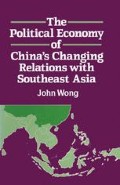Abstract
A special feature of Thailand’s overall relationship with China lies in their strong historical ties. Thailand among the ASEAN countries — Singapore with 76 per cent of its population being Chinese is obviously a special case — has the closest cultural and racial affinities with China, even though modern Thailand does not share a common border with China. Yet Sino-Thai relations during the past three decades have undergone wide fluctuations in terms of sentiments, mutual perception and actual policy orientation. Historically, Thailand was well-known for its remarkable flexibility in its conduct of foreign policy. In order to maintain its territorial integrity, Thailand used to pursue a policy of accommodation with whoever was the dominating power in the region. Thus Thailand initially watched the rising tide of the Communist revolution in China with disinterest and then with concern, especially after China’s entry into the Korea War. In the circumstances, Thailand decided to adopt a cautious but passive policy of non-recognition towards the new government in Beijing.
Preview
Unable to display preview. Download preview PDF.
Notes and References
George Modelski, ‘Thailand and China: From Avoidance to Hostility’ in A. M. Halpern (ed.), Policies Toward China: Views from Six Continents (New York: McGraw-Hill, 1965) p. 365.
Kenneth Perry Landon, The Chinese in Thailand (New York: Russell & Russell, 1941, reissued, 1973) part I.
Ho Ping-Yin, The Foreign Trade of China: Shanghai (The Commercial Press: 1935) ch. 8.
John K. Fairbank, Trade and Diplomacy on the China Coast (Cambridge, Mass.: Harvard University Press, 1953) ch. 2.
G. William Skinner, Chinese Society in Thailand (Ithaca: Cornell University Press, 1957) pp. 5–6.
Sarasin Viraphol, Tribute and Profit: Sino-Siamese Trade, 1652–1853 (Cambridge, Mass.: Harvard University Press, 1977).
See Walter F. Vella, The Impact of the West on Government in Thailand (Berkeley: University of California Press, 1955).
Frank C. Darling, Thailand and the United States (Washington, D.C.: Public Affairs Press, 1965) p. 70.
Daniel D. Lovelace, China and ‘People’s War’ in Thailand, 1964–1969 (Berkeley: University of California Press, 1971) p. 28.
George Modelski (ed.), SEATO: Six Studies (Vancouver, University of British Columbia for Australian National University, 1962).
David A. Wilson, ‘China, Thailand and the Spirit of Bandung’ China Quarterly nos 31 and 32 (April-June and July-September, 1967, 2 parts).
See Benjavan Charoenratha, ‘A Comparison of Thailand’s Relations with the United States and China: 1965–1975’, M. A. thesis (North Texas State University, Denton, Texas, August 1978).
See S. Y. Lee, ‘A Critical Review of Thailand’s Foreign Trade after the War’, FEER (31 March 1955).
George McT. Kahin, The Afro-Asian Conference (Ithaca: Cornell University Press, 1956) pp. 6–7.
Daniel Wolfstone, ‘Peking’s Trade Drive in SE Asia-1. Thailand and Her Ban’, FEER (19 February 1959).
See Melvin Gurtov, China and Southeast Asia -The Politics of Survival (Lexington, Mass.: Heath Lexington, 1971) ch. 2.
See Walter F Hahn, ‘The Nixon Doctrine: Design and Dilemma’, Orbis (Summer, 1972).
Author information
Authors and Affiliations
Copyright information
© 1984 John Wong
About this chapter
Cite this chapter
Wong, J. (1984). Thailand’s Relations with China. In: The Political Economy of China’s Changing Relations with Southeast Asia. Palgrave, London. https://doi.org/10.1007/978-1-349-27929-6_6
Download citation
DOI: https://doi.org/10.1007/978-1-349-27929-6_6
Publisher Name: Palgrave, London
Print ISBN: 978-0-333-28686-9
Online ISBN: 978-1-349-27929-6
eBook Packages: Palgrave Economics & Finance CollectionEconomics and Finance (R0)

